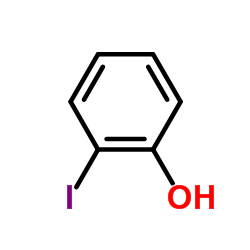Intermediate and mechanism of hydroxylation of o-iodophenol by salicylate hydroxylase.
K Suzuki, T Gomi, E Itagaki
文献索引:J. Biochem. 109(5) , 791-7, (1991)
全文:HTML全文
摘要
Salicylate hydroxylase [EC 1.14.13.1] from Pseudomonas putida catalyzes the hydroxylation of salicylate, and also o-aminophenol, o-nitrophenol, and o-halogenophenols, to catechol. The reactions with these o-substituted phenols comprise oxygenative deamination, denitration, and dehalogenation, respectively. The reaction stoichiometry, as to NADH oxidized, oxygen consumed, and catechol formed, is 2 : 1 : 1, respectively. The mechanisms for the deiodination and oxygenation of o-iodophenol were investigated in detail by the use of I(+)-trapping reagents such as DL-methionine, 2-chlorodimedone, and L-tyrosine. The addition of the traps did not change the molar ratio of catechol formed to NADH oxidized, nor iodinated traps produced were in the incubation mixture. The results suggest that I+ was not produced on the deiodination in the hydroxylation of o-iodophenol. On the other hand, L-ascorbate, L-epinephrine, and phenylhydrazine increased the molar ratio. o-Phenylenediamine decreased it, being converted to phenazine. This suggests that o-benzoquinone is formed in the oxidation of o-iodophenol as a nascent product. The quinone was detected spectrophotometrically by means of the stopped-flow method. Kinetic analysis of the reactions revealed that o-benzoquinone is reduced nonenzymatically to catechol by a second molecule of NADH. A mechanism of elimination for the ortho-substituted groups of substrate phenols by the enzyme is proposed and discussed.
相关化合物
| 结构式 | 名称/CAS号 | 分子式 | 全部文献 |
|---|---|---|---|
 |
2-碘苯酚
CAS:533-58-4 |
C6H5IO |
|
Regioselective synthesis of 1,3,5-substituted benzenes via t...
2011-10-21 [J. Org. Chem. 76(20) , 8472-6, (2011)] |
|
Study on Enhancement Principle and Stabilization for the Lum...
2015-01-01 [PLoS ONE 10 , e0131193, (2015)] |
|
Highly efficient copper-catalyzed domino ring opening and Go...
2009-05-07 [Org. Lett. 11(9) , 1923-6, (2009)] |
|
Copper-catalyzed decarboxylative cross-coupling of alkynyl c...
2010-12-21 [Chem. Commun. (Camb.) 46(47) , 9049-51, (2010)] |
|
Fast speciation analysis of iodophenol compounds in river wa...
2004-06-01 [Electrophoresis 25(12) , 1843-51, (2004)] |